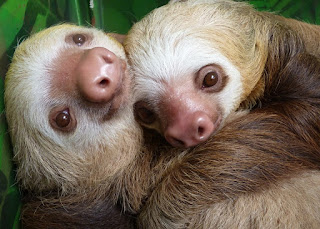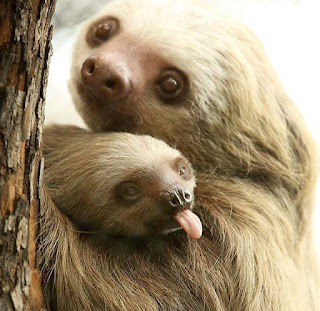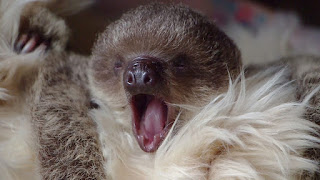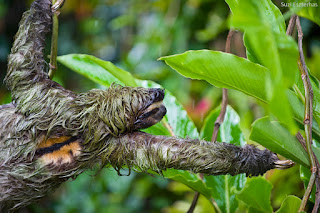The following questions posed to the Sloth Conservation Foundation.
Earlier this week we offered you the chance to have your sloth questions answered by an expert – here is our first question and answer 👉
Q: In the wild adult sloths are solitary but in captivity they are often put in enclosures together… do they mind this?
A: This can sometimes be OK, but sloths usually do not like to share an enclosure with another unknown adult sloth. While sloths are not particularly territorial, they are not a social species and can get surprisingly aggressive with each other. Many rescue centers are able to house adult sloths together if they were raised together as orphans as they develop close bonds in this case. Similarly, if it is a mother / baby pairing they can often stay together after weaning and happily live side by side. Sometimes the adult male can also stay in with the mother / baby pairing if they have been housed together for a long time, but this is high risk. In all other situations it can be very difficult to get two sloths happily living together and many zoos struggle to achieve this!
Continuing with our sloth Q&A 💚
Q: Do orphaned baby sloths get attached to a particular cuddly toy or they are happy with any toy to cling on to.
A: They get attached! A baby sloth will bond with a stuffed cuddly toy a little bit like they bond with mom. They get a lot of comfort from having the same toy to cling onto everyday, but if it gets changed frequently then the attachment doesn’t form. It doesn’t need to even be a cuddly toy – we have seen orphan baby sloths develop very strong attachments to various objects, including other babies and blankets!
Q: What is the lifespan of a sloth?
A: Nobody knows! Seriously – don’t believe anything that you read on the internet about this. It is virtually impossible to determine the age of an adult sloth, and nobody has ever followed a sloth in the wild from birth until death. All we have to go on is the lifespan in captivity, but there are several problems with this. Firstly, sloths do not do well in captivity. The captive diet is often unnaturally high in sugar (for an animal that eats only leaves in the wild) and captive sloths develop a lot of health problems that we don’t see in wild sloths. Second, sloths were not bred in captivity until approximately 50 years ago. Sloths in zoos before that were taken from the wild as adults, and nobody knows how old they were at that point. The oldest known sloth in the world just turned 50 years old and she lives at a zoo in Germany. SloCo founder Dr. Rebecca Cliffe suspects that wild sloths actually live for much longer than this, but only time will tell!
Q: Why don’t adult sloths make noises like baby sloths do?
A: First of all, if anyone hasn’t heard what noise a baby sloth makes we urge you to check this out on youtube. This noise is the baby sloth calling for mom because they are in distress. They typically only make this noise when they have been separated from her and are scared – for orphans in rescue centers this noise gets made when the baby is separated from it’s ‘surrogate mom’ (usually a stuffed toy). Sloths are almost completely blind, so in the wild mom would listen out for this cry to find her baby (if baby fell out of the tree, for example). Adult sloths usually don’t make any sounds because this would attract the attention of predators!
Of course there are some exceptions to this: female three-fingered sloths will make a high pitched scream when she is receptive and looking for a mate, and all three-fingered sloths can make a high pitched squeal when in distress. Adult three-fingered sloths can also make a deep growl when threatened – this can sometimes help to scare off predators! Two-fingered sloths can make a similar growl when angry, and a wild female sloth has been heard making sounds very similar to the cry of a baby after her baby died. Apart from this, they remain silent and stealthy!
Q: I have heard that sloth mouths are teeming with bacteria – what is the source of those bacteria? Do they produce it themselves or is it a result of their diet in the wild?
A: This is a common misconception about sloths – they actually have very clean mouths! Of course there are some natural bacteria present (as is the case for most wild animals) but wild sloths generally have a very ‘clean’ diet consisting of leaves and fruits – this doesn’t lend itself to harboring much bad bacteria! However, sloths have very big teeth and CAN inflict a dangerous bite which will usually require antibiotic treatment to prevent infection, but that would equally be the case for any deep puncture wound that is made with a non-sterile object! We think that the dirty mouth misconception stems from the fact that sloths have black teeth in the wild, but this colour is just from the leaves that they eat!
Q: 👉 I have heard that sloths have moss growing in their fur, is that true? And if so, how do they maintain healthy hair? Are they not bothered by parasites so much?
A: 👉 Almost, but not quite! Sloths DO have things growing in their fur, but it isn’t moss or parasites. In fact sloth hair in home to over 80 different species of fungi and algae, many of which are found nowhere else on Earth – they are unique to sloth fur! Some of these sloth fungi species have even been found to be active against cancer, bacteria and parasites! But why do sloths have this fungi growing in their fur… why doesn’t it grow on other animals? Because sloth fur is specially adapted to host the fungi, with unique cracks and grooves running along each hair! It is a mutually beneficial relationship – the fungi gets a nice place to live, and the sloth gets a nice green coat which is excellent camouflage in the rainforest! Sloths are also surprisingly parasite free as their low body temperature and sunken veins mean that blood-sucking insects like ticks or leeches are not attracted to them! It’s a double win for the sloths! Finally – sloth hair is also remarkably soft and tangle free as sloths in the wild spend unbelievable amounts of time grooming themselves (this looks like the sloth having a good scratch, but they are actually brushing their fur with their fingers).








